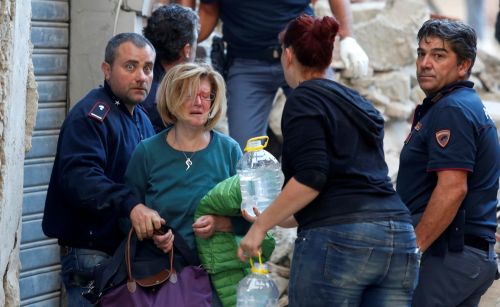
UPDATE: 1:20 AM ET, AUG 25: The number of people killed in the earthquake that devastated
parts of central Italy on Wednesday rose to 247 on
Thursday morning, regional and national officials
said.
UPDATE: 9:11 PM ET, AUG. 24: Rescue teams were working through the night to try to find survivors
under the rubble that remained of central Italian
towns flattened by an earthquake that hit in the
early hours of Wednesday, killing at least 159
people.
UPDATE 1:30 PM ET, AUG. 24: A powerful earthquake flattened mountain towns in central
Italy on Wednesday, killing at least 120 people,
burying some alive in their sleep under mounds of
rubble, as exhausted volunteers and firefighters
raced to free those still trapped.
ACCUMOLI, Italy — One hotel that collapsed in the
small town of Amatrice probably had about 70
guests, and only seven bodies had so far been
recovered, said the mayor of the town that was one
of the worst hit by the quake.
The strong 6.2 magnitude quake razed homes and
buckled roads in a cluster of mountain communities
140 km (85 miles) east of Rome. It was powerful
enough to be felt in Bologna to the north and
Naples to the south, each more than 220 km (135
miles) from the epicentre.
“Tonight will be our first nightmare night,” said
Alessandro Gabrielli, one of hundreds preparing to
sleep in tents erected by rescue workers in fields
and parking lots, each one housing 12 people
whose homes had been destroyed.
“Last night, I woke up with a sound that sounded
like a bomb,” he added.
Rescuers working with emergency lighting in the
darkness saved a 10-year-old girl, pulling her out
of the rubble alive, where she had lain for some 17
hours in the hamlet of Pescara del Tronto.
Many other children were not so lucky. In the
nearby village of Accumoli, a family of four,
including two boys aged 8 months and 9 years,
were buried when their house imploded.
As rescue workers carried away the body of the
infant, carefully covered by a small blanket, the
children’s grandmother blamed God: “He took them
all at once,” she wailed.
Prime Minister Matteo Renzi said the Cabinet would
meet on Thursday to decide measures to help the
affected communities.
“Today is a day for tears, tomorrow we can talk of
reconstruction,” he told reporters late on
Wednesday as he announced 120 bodies had been
found and 368 people had been taken to hospital.
TOLL COULD CLIMB
The death toll rose to 159 a few hours later. With
people still unaccounted for, the civil protection
department warned it could climb higher.
Aerial photographs showed whole areas of
Amatrice, last year voted one of Italy’s most
beautiful historic towns, flattened by the quake.
Inhabitants of the four worst-hit small towns rise
by as much as tenfold in the summer, and many of
those killed or missing were visitors.
Amatrice’s mayor, Sergio Pirozzi, said its best-
known accommodation, Hotel Roma, which
probably had around 70 guests at the time of the
quake, had collapsed and only seven bodies had
been found under the rubble.
The civil protection agency said it was trying to
determine how many people were staying in the
hotel.
Most of the damage was in the Lazio and Marche
regions, with Lazio bearing the brunt of the
damage and the biggest toll. Neighbouring Umbria
was also affected. All three regions are dotted with
centuries-old buildings susceptible to earthquakes.
Italy’s earthquake institute, INGV, said the epicentre
was near Accumoli and Amatrice, which lie
between the larger towns of Ascoli Piceno to the
northeast and Rieti to the southwest.
Italy’s earthquake institute, INGV, said the epicentre
was near Accumoli and Amatrice, which lie
between the larger towns of Ascoli Piceno to the
northeast and Rieti to the southwest.
It was relatively shallow at 4 km (2.5 miles) below
the earth’s surface. INGV reported 150 aftershocks
in the 12 hours following the initial quake, the
strongest measuring 5.5.
Italy sits on two fault lines, making it one of the
most seismically active countries in Europe.
The last major earthquake to hit the country struck
the central city of L’Aquila in 2009, killing more
than 300 people.
The most deadly temblor since the start of the 20th
century came in 1908, when an earthquake
followed by a tsunami killed an estimated 80,000
people in the southern regions of Reggio Calabria
and Sicily.
(Additional reporting by Gabriele Pileri and Roberto
Mignucci, Writing by Philip Pullella and Gavin Jones;
Editing by Louise Ireland and Peter Cooney)
Most of the damage was in the Lazio and Marche
regions. Neighboring Umbria was also affected. All
three regions are dotted with centuries-old
buildings susceptible to earthquakes
The U.S. Geological Survey measured the quake at
6.2 and said it struck near the Umbrian city of
Norcia. Italy’s earthquake institute INGV registered
it at 6.0 and put the epicenter further south, closer
to Accumoli and Amatrice.
INGV reported 150 aftershocks in the 12 hours
following the initial quake, the strongest measuring
5.5.
The damage was made more severe because the
epicenter was at a relatively shallow 4 km below
the surface of the earth. Residents of Rome were
woken by the tremors, which rattled furniture,
swayed lights and set off car alarms in most of
central Italy.
“It was so strong. It seemed the bed was walking
across the room by itself with us on it,” Lina
Mercantini of Ceselli, Umbria, about 75 km away
from the hardest hit area, told Reuters.
Italy sits on two fault lines, making it one of the
most seismically active countries in Europe.
The last major earthquake to hit the country struck
the central city of L’Aquila in 2009, killing more
than 300 people.
The most deadly since the start of the 20th century
came in 1908, when an earthquake followed by a
tsunami killed an estimated 80,000 people in the
southern regions of Reggio Calabria and Sicily.
($1 = 0.8868 euros)
(Writing by Crispian Balmer and Philip Pullella,
reporting by Steve Scherer, Philip Pullella, Stephen
Jewkes, Eleanor Biles and Giulia Segreti.; Editing by
Robert Birsel, Peter Graff and John Stonestreet)
Source: www.ChristianPost.com
STOP!!!Want To Promote Your Song?



